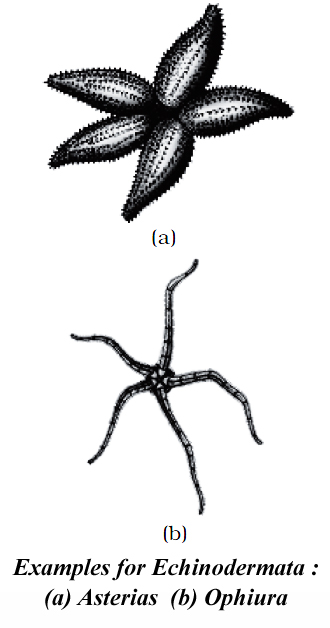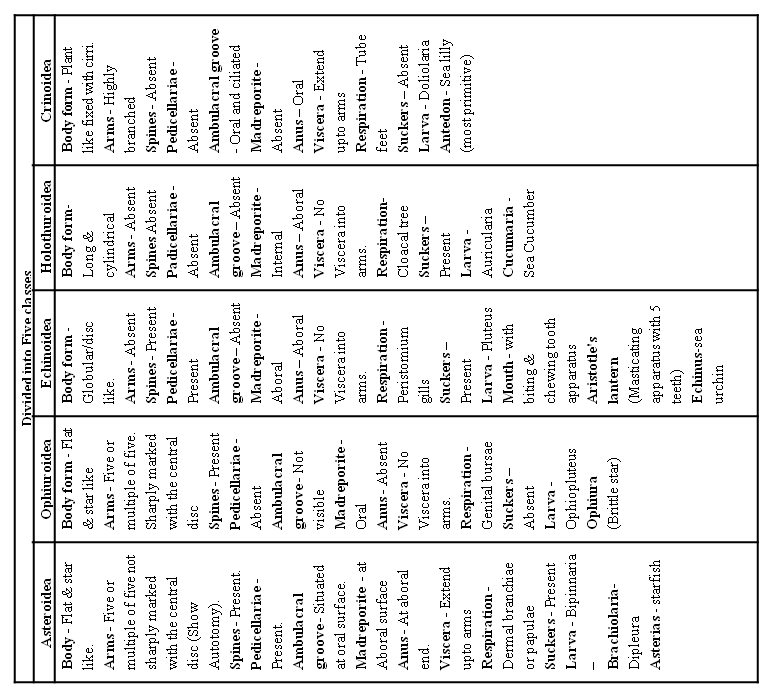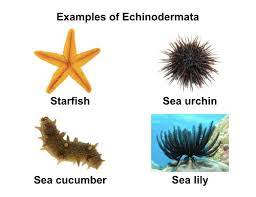- Books Name
- ACME SMART COACHING Biology Book
- Publication
- ACME SMART PUBLICATION
- Course
- CBSE Class 11
- Subject
- Biology
10. PHYLUM: ECHINODERMATA

They are exclusively present in marine water and there are no parasitic forms. Similarities with chordates :
(i) They have tube within tube type of body plan which has evolved along deuterostomic evolutionary line.
(ii) They possess a true coelom called enterocoelom.
(iii) They have mesodermal skeleton made of calcareous plates or ossicles.
All these characters make the echinoderms closer to chordates. The other characters are :
1. The symmetry is bilateral in larvae but pentamerous radial in adults.
2. Many echinoderms bear a number of calcareous spines on their body surfaces called tubercles. Between the spines, there are pincer like structures called pedicellariae to keep the surface clean. Pedicellariae are made of three calcareous plates. Two calcareous valve like structures in the form of jaws resting upon a basal calcareous plate.
3. Between the spines, there are finger like processes called dermal branchiae which help in respiration.
4. Mouth is on ventral/oral side and aniss is on dorsal or aboral side.
5. There is no distinct anterior and posterior end i.e., no cephalisation.
6. Haemal and Perihaemal Systems: Instead of blood vascular system, there are present haemal and perihaemal systems which are of coelomic origin. Thus the so called circulatory system is open type. The so called blood is often without a respiratory pigment. There is no heart.
7. Respiratory Organs : Gaseous exchange occurs by dermal branchiae or papulae in star fishes, peristominal gills in sea urchins, genital bursae in brittle stars and cloacal respiratory trees in holothurians. Exchange of gases also takes place through tube feet.
8. Excretory organs : Specialized excretory organs are absent. Nitrogenous wastes are diffused out via gills or dermal branchiae. Ammonia is chief excretory matter.
9. Sexes are separate. Reproduction is sexual. Fertilization is usually external. Development is indirect with free-swimming larva.
CLASSIFICATION

Concept Builder
1. The starfish uses the suction cup-like ends of the tube feet of one arm to hold on to rocks, as it moves the other arms. It can open bivalves (molluscs) by attaching two arms to either sides of a bivalve and pulling them apart. The bivalve opens out, the stomach of starfish is then everted through its mouth and introduced into the open mollusc which is partly digested before being ingested. Echinoderms predate on coral polyps also.
2. Word roots and origin : ampulla from Latin meaning ''flask''.
Phylum Echinodermata
Invertebrates with spiny skin are known as echinoderms. The endoskeleton of these creatures is made up of calcareous ossicles. All of them are marine, having organ-system organization. There are no freshwater or terrestrial organisms in this phylum. Adult echinoderms have radial symmetry, whereas larvae have bilateral symmetry. They are coelomate and triploblastic creatures. With the mouth on the bottom (ventral) side and the anus on the upper (dorsal) side, the digestive system is complete. Echinoderms are distinguished by the presence of a water vascular system that aids motility, food capture and transport, and breathing. This system has a central ring canal and radial canals that extend along each arm. Through these structures, water circulates. The madreporite is a structure present on top of the body. This is responsible for the regulation of the water in the water vascular system. There is no excretory system. Sexes are distinct. Reproduce sexually. External fertilization is common. The development of free-swimming larva is indirect. Asterias (starfish), Echinus (sea urchin), Antedon (sea lily), Cucumaria (sea cucumber), and Ophiura (Brittle star) are among examples.


 ACME SMART PUBLICATION
ACME SMART PUBLICATION
